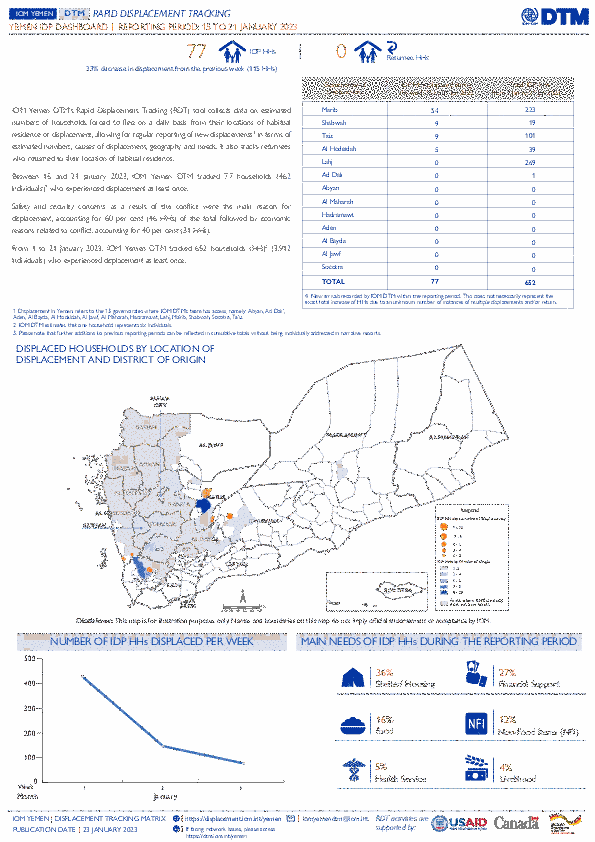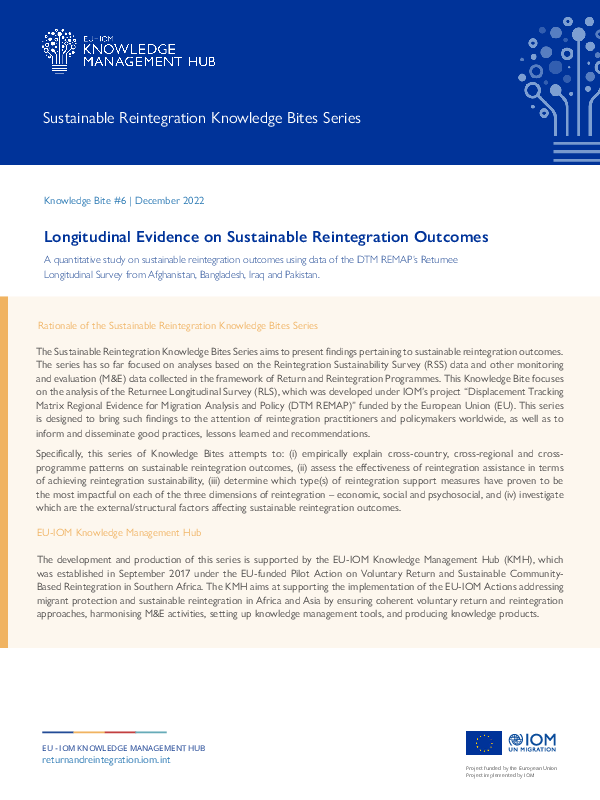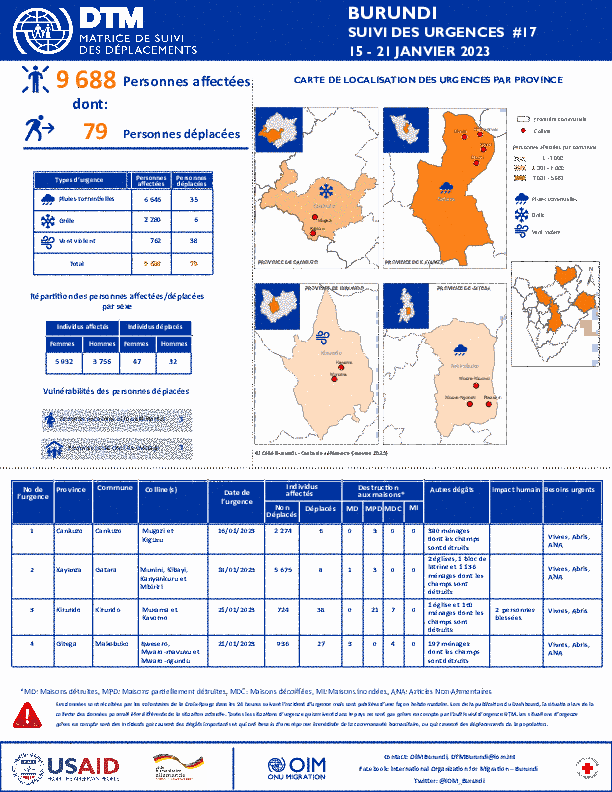-
Countries
-
Data and Analysis
-
Special Focus
-
Crisis Responses

Contact
DTM Niger, DTMNiger@iom.int
Language
French
Location
Niger
Period Covered
Dec 01 2022
Dec 31 2022
Activity
- Flow Monitoring
L’OIM, à travers l’outil de suivi des flux de populations (Flow Monitoring en anglais) de la Matrice de suivi des déplacements (Displacement Tracking Matrix, DTM en anglais), récolte des données à des points d’entrée, de sortie et de transit clés afin de mieux comprendre les mouvements de populations à travers l’Afrique de l’Ouest et du Centre. Le suivi des flux de population est une activité qui permet de quantifier et de qualifier les flux et tendances de mobilités, les profils des migrants, et les expériences et routes migratoires. Depuis 2016, plusieurs points de suivi des flux de populations ont été progressivement installés dans d'importantes localités du Niger pour faire le suivi des flux migratoires dans le pays. La période de collecte de ce rapport s’est faite du 1er au 31 Décembre 2022 afin d’observer la tendance de la migration durant le mois.
This sixth Knowledge Bite focuses on the analysis of the DTM REMAP’s Returnee Longitudinal Survey (RLS). The RLS was conducted in Afghanistan, Bangladesh, Iraq and Pakistan based on three rounds of data collection in each country. The analysis follows previous Knowledge Bites that relied on the Reintegration Sustainability Survey (RSS) and focuses on four reintegration scores of returnees: economic, social, psychosocial and a composite one. The RLS was collected from 2020 to 2022. As such, the dynamics reported in this Knowledge Bite should be interpreted in the context of the global COVID-19 pandemic, and in the case of Afghanistan, the political transition by the De Facto Authorities (DFA) and its economic impact on the country.
Contact
DTM Burundi, DTMBurundi@iom.int
Location
Burundi
Activity
- Mobility Tracking
- Event Tracking
Period Covered
Jan 15 2023 -Jan 21 2023
Activated on an ad hoc basis, the DTM Emergency Tracking provides early field reports at the beginning of a complex crisis, allowing IOM to gather, consolidate and disseminate baseline information on displacement and return figures at the onset of a newly emerging crisis. The DTM Emergency Tracking relies heavily on information provided by RARTs or partners within the humanitarian community about an unfolding situation. The Emergency Tracking gathers data through IOM Burundi’s extended network of key informants, who provide basic information on the new displacement, be it of IDPs or returnees, or both, including numbers, location and shelter types. While IOM DTM strives to provide best estimates, the Emergency Tracking aims to be a quick monitoring tool with real-time data turnover ranging from 24 to 72 hours following its activation.
Population Groups
Survey Methodology
Unit of Analysis Or Observation
Type of Survey or Assessment
Keywords
Geographical Scope
Administrative boundaries with available data
The current dataset covers the following administrative boundaries
Contact
DTM Yemen, iomyemendtm@iom.int
Location
Yemen
Activity
- Mobility Tracking
- Event Tracking
Period Covered
Jan 15 2023 -Jan 21 2023
From 1 January to 21 January 2023, IOM Yemen DTM tracked 652 households (HH) (3,912 Individuals) who experienced displacement at least once.
Between 15 and 21 January 2023, IOM Yemen DTM tracked 77 households (462 individuals) displaced at least once. The majority of people moved into/within the following governorates and districts:
- Marib (54 HHs) – Marib City (37 HHs), Marib (17 HHs) districts. Most displacements in the governorate originated from Taiz and Ibb.
- Taiz (9 HHs) – Jabal Habashi (5 HHs), Sabir Al Mawadim (4 HHs) districts. All displacements in the governorate were internal.
- Shabwah (9 HHs) – Osaylan (7 HHs), Ayn (2 HHs) districts. All displacements in the governorate orginiated from Marib.
- Taiz (21 HHs) – Maqbanah (7 HHs), Jabal Habashi (6 HHs), Al Qahirah (3 HHs) districts.
- Marib (15 HHs) – Al Jubah (9 HHs), Al Abdiyah (2 HHs), Mahliyah (2 HHs) districts.
- Ibb (8 HHs) – Hazm Al Odayn (3 HHs), Hobeish (2 HHs), Al Qafr (1 HHs) districts.
Population Groups
Survey Methodology
Unit of Analysis Or Observation
Type of Survey or Assessment
Keywords
Geographical Scope
Administrative boundaries with available data
The current dataset covers the following administrative boundaries

Contact
DTM Yemen, iomyemendtm@iom.int
Language
English
Location
Yemen
Period Covered
Jan 15 2023
Jan 21 2023
Activity
- Mobility Tracking
Dear Yemen Humanitarian Data Partners,
IOM Yemen DTM’s Rapid Displacement Tracking (RDT) tool collects data on estimated numbers of households forced to flee on a daily basis from their locations of origin or displacement, allowing for regular reporting of new displacements in terms of estimated numbers, geography, and needs. It also tracks returnees who returned to their location of origin.
From 1 January to 21 January 2023, IOM Yemen DTM tracked 652 households (HH) (3,912 Individuals) who experienced displacement at least once.
Between 15 and 21 January 2023, IOM Yemen DTM tracked 77 households (462 individuals) displaced at least once. The majority of people moved into/within the following governorates and districts:
- Marib (54 HHs) – Marib City (37 HHs), Marib (17 HHs) districts. Most displacements in the governorate originated from Taiz and Ibb.
- Taiz (9 HHs) – Jabal Habashi (5 HHs), Sabir Al Mawadim (4 HHs) districts. All displacements in the governorate were internal.
- Shabwah (9 HHs) – Osaylan (7 HHs), Ayn (2 HHs) districts. All displacements in the governorate orginiated from Marib.
The majority of people moved from the following governorates and districts:
- Taiz (21 HHs) – Maqbanah (7 HHs), Jabal Habashi (6 HHs), Al Qahirah (3 HHs) districts.
- Marib (15 HHs) – Al Jubah (9 HHs), Al Abdiyah (2 HHs), Mahliyah (2 HHs) districts.
- Ibb (8 HHs) – Hazm Al Odayn (3 HHs), Hobeish (2 HHs), Al Qafr (1 HHs) districts.
Monthly Overview of:
- Arrivals in the Western Balkans
- Top three nationalities at arrivals in the reporting month
- Migrants presence in reception facilities
- Migrants presence outside reception facilities
- Ukrainian nationals in the Western Balkans
- Returns and reintegration

Contact
DTM Yemen, DTMYemen@iom.int
Language
Arabic
Location
Yemen
Period Covered
Sep 07 2022
Sep 30 2022
Activity
- Mobility Tracking
- Site Assessment
- Baseline Assessment
أجرى فريق مصفوفة تتبع النزوح التابع للمنظمة الدولية للهجرة استطلاعاً عن مقاصد النازحين في 23 موقع للنزوح في مديرية مدينة مأرب في محافظة مأرب في الفترة ما بين 7 و 30 سبتمبر 2022. وبعد يومين من جمع المعلومات انقضت الهدنة التي بدأت منذ 2 إبريل 2022. وعلى الرغم من مضي نصف عام من الهدنة، إلا أن المنظمة الدولية للهجرة قابلت عدداً قليلاً من الأسرالتي تنوي مغادرة مواقع النزوح التي تم تقييمها. وهناك 61 موقعاً إجمالياً في مديرية مدينة مأرب، و 198 موقعاً في محافظة مأرب وفقاً لمعطيات كتلة تنسيق وإدارة المخيمات في اليمن.
وتمثل عينة الأسر التي شملها الإستبيان والبالغ عددها 2,227 أسرة ما يعادل 11 بالمائة من إجمالي عدد الأسر في المواقع التي تم تقييمها والبالغ عددها ( 21,014 أسرة ) مايعادل 14,784 فرد، وبمعدل 6.6 فرد للأسرة. ويبلغ متوسط عدد سكان الموقع حوالي 450 أسرة لكل موقع تم تقييمه باستثناء الجفينة الذي يضم 11,200 أسرة في الوقت الحالي. وقيم فريق مصفوفة تتبع النزوح ما معدله 12 بالمائة من السكان في كل موقع، بما لايقل عن 40 أسرة، وكان العدد الأكبر في الجفينة حيث قابل فريق مصفوفة تتبع النزوح 1,126 أسرة.
ويتابع فريق مصفوفة تتبع النزوح التابع للمنظمة الدولية للهجرة حالات النزوح الجديدة عبر أداة التتبع السريع للنزوح في 13 محافظة جنوبية تحت سيطرة الحكومة المعترف بها دولياً. وضمن هذا النطاق، كانت محافظة مأرب هي الأولى من بين المحافظات من حيث أعلى عدد للأسر. حديثة النزوح خال الفترة ما بين يناير وسبتمبر 2022 وسجلت المنظمة الدولية للهجرة 8,975 حالة نزوح جديدة للأسر خلال الأشهر التسعة الماضية، منها 2,350 أسرة (26%) نزحت إلى مأرب أو داخلها، تليها الحديدة. (1,983 أسرة 22%) وشبوة (1,448 أسرة، %16).





